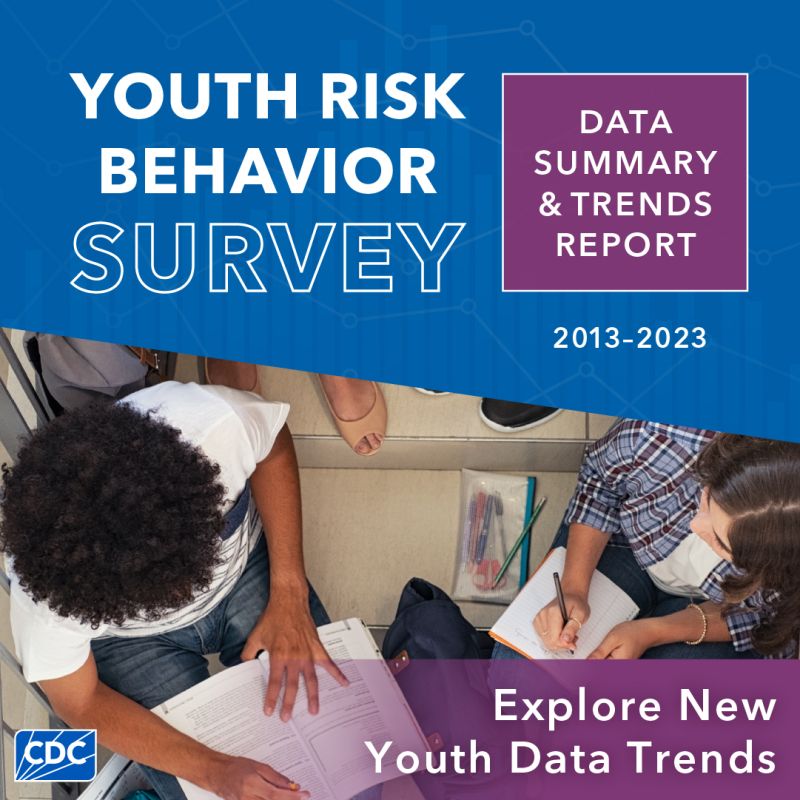
The Youth Risk Behavior Survey Data Summary & Trends Report: 2013–2023 tells an important story about adolescent health and well-being.
The report describes recent Youth Risk Behavior Survey (YRBS) data and trends on adolescent behaviors and experiences in key areas.
Focus of the report
The Youth Risk Behavior Survey Data Summary & Trends Report provides data on health behaviors and experiences of high school students in the United States. Data highlight students’ behaviors and experiences in 2023, changes from 2021 to 2023, and 10-year trends. The report focuses on:
- Sexual behavior
- Substance use
- Experiences of violence
- Mental health
- Suicidal thoughts and behaviors
- Other important issues, like social media use)

Key findings
- In 2023, female students and LGBTQ+ students experienced more violence, signs of poor mental health, and suicidal thoughts and behaviors than their male and cisgender and heterosexual peers.
- From 2021 to 2023, there were early signs that adolescent mental health is getting better. There were also concerning increases in students’ experiences of violence at school.
- From 2013 to 2023, 10-year trends were similar to what data showed in 2021. There were decreases in students’ use of substances. There were increases in students’ experiences of violence, signs of poor mental health, and suicidal thoughts and behaviors. Students’ sexual activity decreased, but so did their protective sexual behaviors, like condom use.

Key Findings on New and Emerging Issues
The 2021 and 2023 national YRBS questionnaires included new questions on urgent and emerging issues for adolescents. These issues include racism in school, unfair discipline in school, social media use, school connectedness, unstable housing, and parental monitoring Data
from 2023 highlighted important findings:
- Overall, almost a third of students reported that they had ever experienced racism in school. Asian students were more likely than most other groups to report ever experiencing racism in school, and White students were less likely than most other groups to report ever experiencing racism in school.
- Almost 1 in 5 students reported being unfairly disciplined at school Male students were more likely than female students to report being unfairly disciplined Black students were more likely than White and Hispanic students to report being unfairly disciplined, with no other significant differences between groups.
- Only about half of students felt close to people at school Male students were more likely than female students to feel close to people at school Cisgender and heterosexual students were more likely than LGBTQ+ students to feel close to people at school.
- More than three quarters of students said they used social media several times a day. Female students were more likely than male students to use social media American Indian or Alaska Native students were less likely than students from most other racial and ethnic groups to use social media.
Schools play a large role in youths’ lives and development Partnering with and supporting schools has the potential to reach large numbers of young people with strategies that can make a positive impact.
Actions to Improve Adolescent Health and Well-Being
Schools play a large role in youths’ lives and development Partnering with and supporting schools has the potential to reach large numbers of young people with strategies that can make a positive impact.
CDC developed an action guide with strategies schools can use to improve mental health These six strategies include increasing students’ mental health literacy; promoting mindfulness; promoting social, emotional, and behavioral learning; enhancing connectedness; providing psychosocial skills training and cognitive behavioral interventions; and supporting staff well-being.
Download Promoting Mental Health and Well-Being in Schools: An Action Guide for School and District Leaders.
Download the Youth Risk Behavior Survey report (4 MB)
Source: Centers for Disease Control and Prevention | Youth Risk Behavior Survey Data Summary & Trends Report: 2013–2023, https://www.cdc.gov/yrbs/dstr/index.html#cdc_publication_summary_guidance-key-findings | public domain. U.S. Department of Health and Human Services; 2024.
This resource is filed under:





